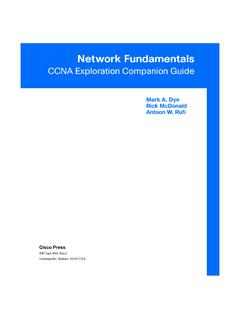Transcription of Application Layer Functionality and Protocols
1 CHAPTER 3 Application Layer Functionality and ProtocolsObjectivesUpon completion of this chapter, you will be able to answer the following questions: How do the functions of the three upper OSImodel layers provide network services to end-user applications ? How do the TCP/IP Application Layer protocolsprovide the services specified by the upper layers of the OSI model? How do people use the Application Layer to communicate across the information network ? What are the functions of well-known TCP/IPapplications, such as the World Wide Web and e-mail, and their related services (HTTP, DNS,DHCP, STMP/POP, and Telnet)?
2 What are the file-sharing processes that usepeer-to-peer applications and the Gnutella protocol? How do Protocols ensure that services runningon one kind of device can send to and receivefrom many different network devices? How can you use network analysis tools toexamine and explain how common user applications work?Key TermsThis chapter uses the following key terms. You can find the definitions in the page 67source devicepage 67 Domain Name System (DNS)page 68 Request for Comments (RFC)page 68syntaxpage 70sessionpage 71clientpage 72serverpage 72daemon page 73peerpage 75schemepage 76IP addresspage 77domain name page 77network addresspage 78resource recordpage 78 DNS resolverpage 78nslookuppage 78query page 78cachepage 79authoritative page 10/11/07 10.
3 11 AM Page 63plug-inpage 82 HTTP page 82distributedpage 82collaborative page 82encryptionpage 82 Post Office Protocol (POP)page 83 Simple Mail Transfer Protocol (SMTP)page 83 Mail User Agent (MUA)page 83spam page 85gateway page 85 Dynamic Host Configuration Protocol (DHCP)page 87subnet maskpage 87broadcastpage 88 Server Message Block (SMB)page 89 UNIX page 89 Interpret as Command (IAC)page 9164 network fundamentals , ccna exploration companion 10/11/07 10:11 AM Page 64 The world experiences the Internet through the use of the World Wide Web, e-mail, andfile-sharing programs.
4 These applications , as well as others, provide the human interface tothe underlying network , allowing you to send and receive information with relative of the applications are intuitive; they can be accessed and used without the need toknow how they work. As you continue to study the world of networking, it becomes moreimportant to know how an Application is able to format, transmit, and interpret messagesthat are sent and received across the the mechanisms that enable communication across the network is made easier ifyou use the layered framework of the Open System Interconnection (OSI) model.
5 Figure 3-1 depicts that framework. The OSI model is a seven- Layer model, designed to help explainthe flow of information from Layer to 3-1 Interfacing Human and Data NetworksThis chapter focuses on the role of Layer 7, the Application Layer , and its components: applications , services, and Protocols . You explore how these three elements make the robustcommunication across the information network : The Interface Between theNetworksThis section introduces two important concepts: Application Layer :The Application Layer of the OSI model provides the first step ofgetting data onto the 3: Application Layer Functionality and Protocols65 ApplicationThe Application Layer providesthe interface to the Link2 Data 10/11/07 10:11 AM Page 65 Application software.
6 applications are the software programs used by people to com-municate over the network . Examples of Application software, including HTTP, FTP,e-mail, and others, are used to explain the differences between these two and TCP/IP ModelThe OSI reference model is a layered, abstract representation created as a guideline for net-work protocol design and instruction. The OSI model divides the networking process intoseven logical layers, each of which has unique Functionality and to which are assigned spe-cific services and the OSI model, information is passed from one Layer to the next, starting at the applica-tion Layer on the transmitting host and proceeding down the hierarchy to the physical Layer ,then passing over the communications channel to the destination host, where the informa-tion proceeds back up the hierarchy, ending at the Application Layer .
7 Figure 3-2 depicts thesteps in this process. The following explains the six create the Application Layer prepares human communication for transmission over the and hardware convert communication to a digital Layer services initiate the data Layer plays its role. The OSI layers encapsulate data down the stack. Encapsulateddata travels across the media to the destination. OSI layers at the destination unencap-sulate the data up the Application Layer receives data from the network and prepares it for human use.
8 Figure 3-2 OSI Encapsulation Process66 network fundamentals , ccna exploration companion GuideApplicationOSI ModelOSI Model7 Application7 PresentationPeople create applicationlayer prepareshumancommunicationfor transmissionover the andhardware convertcommunicationto a digital Layer servicesinitiate the data Application Layer receivesdata from the network andprepares it for human layerplays its Link2 Data 10/11/07 10:11 AM Page 66 The Application Layer , Layer 7, is the top Layer of both the OSI and TCP/IP models.
9 (Referto the section Protocol and Reference Models in Chapter 2, Communicating over theNetwork, for more information about the TCP/IP model.) Layer 7 provides the interfacebetween the applications you use to communicate and the underlying network over whichyour messages are transmitted. Application Layer Protocols are used to exchange databetween programs running on the source and destination hosts. There are many applicationlayer Protocols , and new Protocols are always being developed. (Refer to the section UserApplications, Services, and Application Layer Protocols , later in this chapter, for examples.)
10 Although the TCP/IP protocol suite was developed prior to the definition of the OSI model,the Functionality of the TCP/IP Application Layer Protocols fits roughly into the frameworkof the top three layers of the OSI model: Application , presentation, and applications , such as web browsers or e-mail clients, incorporate Functionality of theOSI Layers 5, 6, and 7. A comparison of the OSI and TCP/IP model is shown in Figure 3-3 OSI and TCP/IP ModelMost TCP/IP Application Layer Protocols were developed before the emergence of personalcomputers, GUIs, and multimedia objects.










